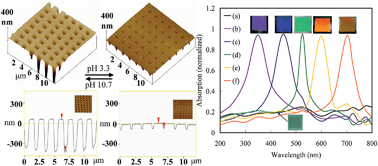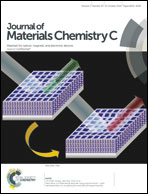Fabrication of metamaterial absorber using polymer brush – gold nanoassemblies for visualizing the reversible pH-responsiveness
Abstract
Poly(2-dimethylaminoethyl methacrylate) was grafted onto flat silicon substrates via atom transfer radical polymerization to form bottom layers. Two fabrication processes, very-large-scale integration and reactive ion etching, were applied in sequence to generate 400 nm-scale hole arrays of tethered poly(2-dimethylaminoethyl methacrylate) layers as sub-wavelength hole array on the Si surfaces, followed by the immobilization of surface functionalized gold nanoparticles by means of physical interaction (electrostatic attraction, entanglement, and hydrogen bonding) to generate a metamaterial absorber. Hole dimensions of the metamaterial absorber shrank reversibly and significantly upon changing the pH from 10.7 and 3.3 due to swelling behavior, leading to a significant change in surface plasmon resonance. We found that the change in the surface plasmon resonance of the metamaterial absorber, related to the dimensions of its holes upon pH treatment, resulted in a color change from purple to orange, observable by the naked eye at a fixed angle of 10°. The maximum shift of the absorptive peak position was greater than 300 nm, and these shifts corresponded to the color changes in the solutions at various values of pH.

- This article is part of the themed collection: 2014 Journal of Materials Chemistry C Hot Articles

 Please wait while we load your content...
Please wait while we load your content...